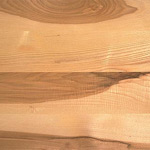For a quicker response, please send all inquiries
via info@canfloor.com or
text to
416-735-0075.
| Monday - Friday | 10:00 am - 7:00 pm |
| Saturday & Sunday | 10:30 am - 4:00 pm |

Scientific Name: Carya spp.
Other Names and Species: Bitter Pecan, Bitternut Hickory, Mockernut, Pecan Hickory, Pignut, Shagbark, Shellbark, Swamp Hickory, White Hickory
Origin: North America
Appearance: These related species have a similar appearance and characteristics. While hickory heartwood is tan or reddish, with white to tan sapwood, pecan heartwood tends to be reddish brown with brown stripes, and the sapwood is white or creamy white with pinkish tones. The open grain of pecan, which is wavy or irregular, contrasts nicely with the closed, rough-textured grain of hickory. Traditionally, flooring mills mix hickory and pecan together.
Properties: Prized for their resiliency, both hickory and pecan wood are exceedingly high in shock resistance, and they rank as the hardest of all North American hardwoods. Their combination of stiffness, toughness, hardness, and durability can be found in no other commercial wood, which is why they are used when an extremely hard and durable wood floor is desired.
Workability: The density of both hickory and pecan is such that they are difficult to work and sand. Moreover, the light color of these woods makes the sander marks more pronounced than in darker types of wood. They have good holding ability but are prone to splitting. Pre-drilling is recommended.
Principal Uses: Hickory and pecan are especially favored by log home owners who want a beautiful rustic effect in their wood flooring. These woods are also used in the manufacture of veneers, tool handles, furniture, cabinetry, ladder rungs, dowels, and sporting goods such as baseball bats, archery equipment, and skis.
